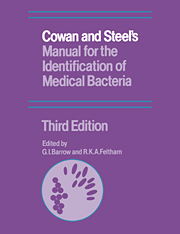Book contents
- Frontmatter
- Contents
- Foreword
- Preface to the first edition
- Postscript
- Preface to the second edition
- Preface to the third edition
- List of contributors
- Introduction
- 1 Classification and nomenclature
- 2 Culture media: constituents and sterilization
- 3 Principles of isolation
- 4 Bacterial characters and characterization
- 5 Theory and practice of bacterial identification
- 6 Characters of Gram-positive bacteria
- 7 Characters of Gram-negative bacteria
- 8 Taxonomy in theory and practice
- 9 Bacterial identification by cards
- 10 Bacterial identification by computer
- 11 Quality control in microbiology
- Appendices
- References
- Index
7 - Characters of Gram-negative bacteria
Published online by Cambridge University Press: 15 December 2009
- Frontmatter
- Contents
- Foreword
- Preface to the first edition
- Postscript
- Preface to the second edition
- Preface to the third edition
- List of contributors
- Introduction
- 1 Classification and nomenclature
- 2 Culture media: constituents and sterilization
- 3 Principles of isolation
- 4 Bacterial characters and characterization
- 5 Theory and practice of bacterial identification
- 6 Characters of Gram-positive bacteria
- 7 Characters of Gram-negative bacteria
- 8 Taxonomy in theory and practice
- 9 Bacterial identification by cards
- 10 Bacterial identification by computer
- 11 Quality control in microbiology
- Appendices
- References
- Index
Summary
Although not ideal for making a major subdivision of bacteria, Gram's method of staining is convenient because everyone uses it (in one of its many modifications) when characterizing a bacterium. There is an unfortunate tendency to omit this step, especially when dealing with cultures isolated on selective media which, by virtue of the inhibitory agents they contain, may in theory affect the bacterial staining reactions; it is simply assumed that colonies on selective media have the appropriate (or expected) tinctorial and shapely qualities. This may often be tolerated (and sometimes acceptable) in busy routine laboratories where, in the words of W.S. Gilbert, it may be regarded as ‘merely corroborative detail, intended to give artistic verisimilitude to an otherwise bald and unconvincing narrative’. However, our objectives are neither speed nor artistry; we want to know the identity of the organisms and for this we need accurate characterizations. We cannot afford therefore to omit making smears and staining them by Gram's method, even if we do not pursue microscopy any further.
Division into major groups
Before dealing with the Gram-negative bacteria proper, we would remind readers that there are a few organisms that seem to be on the borderline between the Gram-positive and the Gram-negative, for example Gemella, a genus which until recently was thought to consist of Gram-negative cocci. Other bacteria show an unusual phenomenon in that they develop some Gram-positivity as cultures age, in contrast to the Gram-positive bacteria, which usually become Gram-negative as the cells age and degenerate.
- Type
- Chapter
- Information
- Publisher: Cambridge University PressPrint publication year: 1993
- 14
- Cited by



